The Impact of Diet on Health Outcomes
VerifiedAdded on 2020/05/04
|8
|1582
|98
AI Summary
This assignment analyzes the profound influence of diet on human health. It delves into historical trends in food consumption and their impact on population growth and height. The document highlights the nutritional needs for optimal health, emphasizing the role of balanced diets rich in essential nutrients. It also discusses the link between dietary choices and chronic diseases, comparing the potential risks associated with vegetarianism versus meat-based diets. Finally, it underscores the critical importance of adequate food intake to prevent malnutrition and its associated symptoms.
Contribute Materials
Your contribution can guide someone’s learning journey. Share your
documents today.
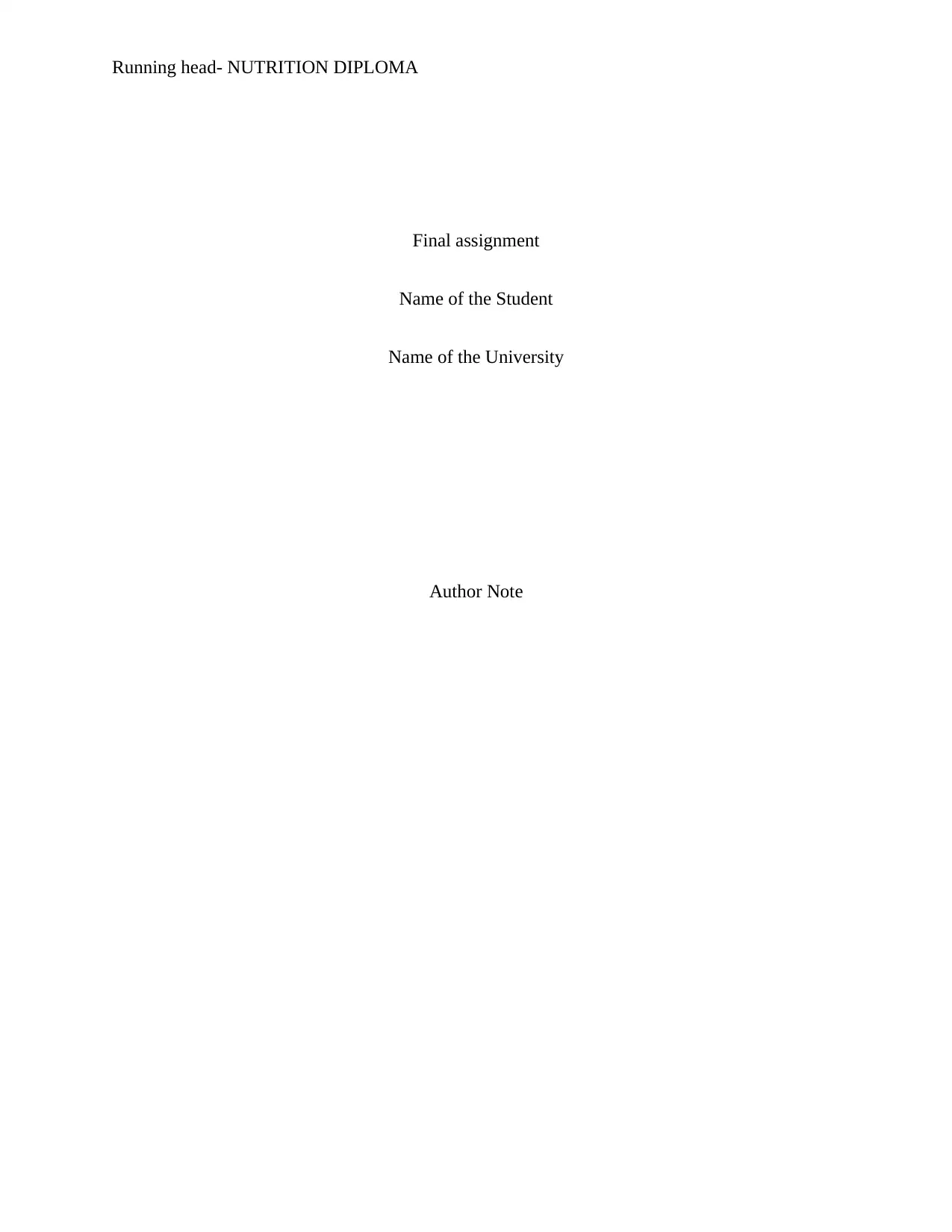
Running head- NUTRITION DIPLOMA
Final assignment
Name of the Student
Name of the University
Author Note
Final assignment
Name of the Student
Name of the University
Author Note
Secure Best Marks with AI Grader
Need help grading? Try our AI Grader for instant feedback on your assignments.
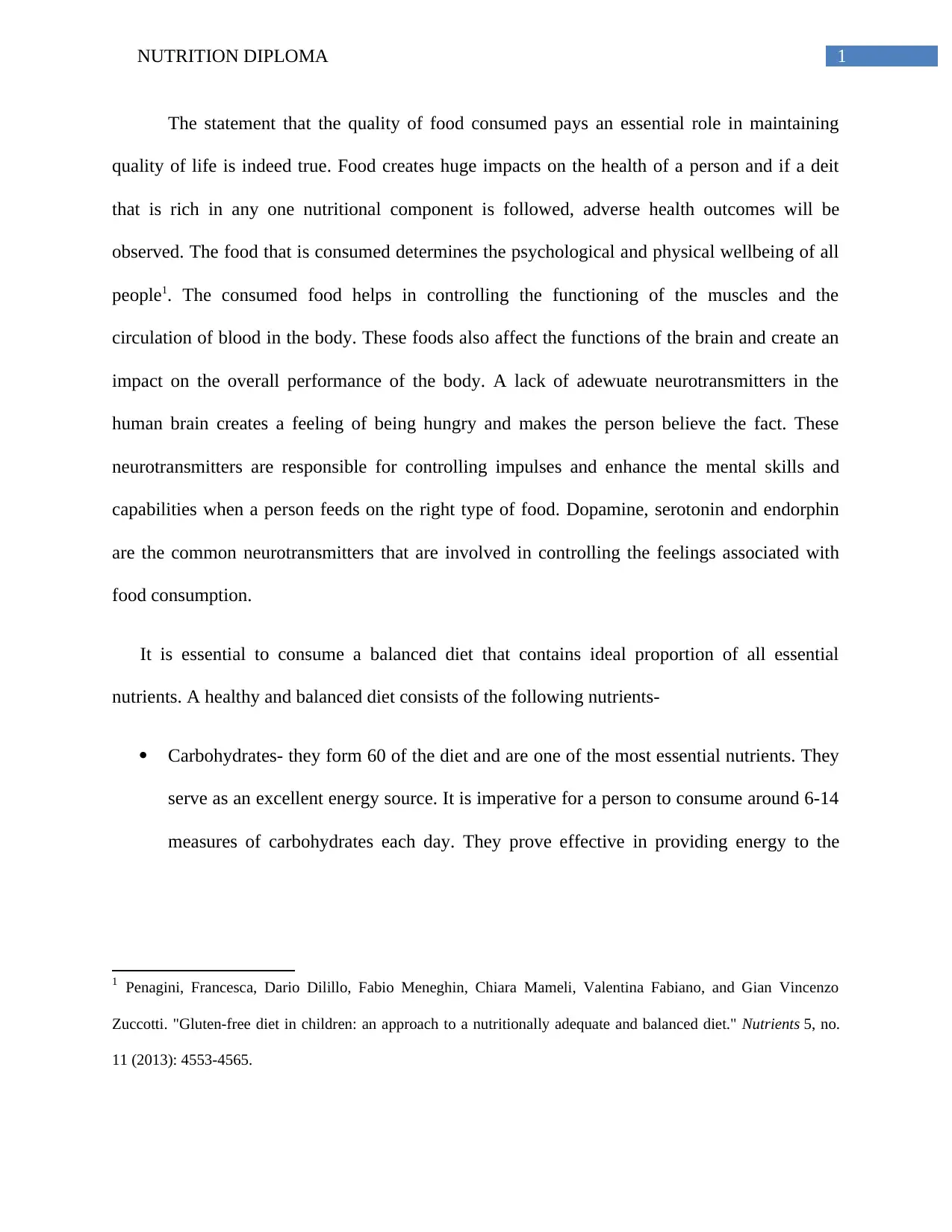
1NUTRITION DIPLOMA
The statement that the quality of food consumed pays an essential role in maintaining
quality of life is indeed true. Food creates huge impacts on the health of a person and if a deit
that is rich in any one nutritional component is followed, adverse health outcomes will be
observed. The food that is consumed determines the psychological and physical wellbeing of all
people1. The consumed food helps in controlling the functioning of the muscles and the
circulation of blood in the body. These foods also affect the functions of the brain and create an
impact on the overall performance of the body. A lack of adewuate neurotransmitters in the
human brain creates a feeling of being hungry and makes the person believe the fact. These
neurotransmitters are responsible for controlling impulses and enhance the mental skills and
capabilities when a person feeds on the right type of food. Dopamine, serotonin and endorphin
are the common neurotransmitters that are involved in controlling the feelings associated with
food consumption.
It is essential to consume a balanced diet that contains ideal proportion of all essential
nutrients. A healthy and balanced diet consists of the following nutrients-
Carbohydrates- they form 60 of the diet and are one of the most essential nutrients. They
serve as an excellent energy source. It is imperative for a person to consume around 6-14
measures of carbohydrates each day. They prove effective in providing energy to the
1 Penagini, Francesca, Dario Dilillo, Fabio Meneghin, Chiara Mameli, Valentina Fabiano, and Gian Vincenzo
Zuccotti. "Gluten-free diet in children: an approach to a nutritionally adequate and balanced diet." Nutrients 5, no.
11 (2013): 4553-4565.
The statement that the quality of food consumed pays an essential role in maintaining
quality of life is indeed true. Food creates huge impacts on the health of a person and if a deit
that is rich in any one nutritional component is followed, adverse health outcomes will be
observed. The food that is consumed determines the psychological and physical wellbeing of all
people1. The consumed food helps in controlling the functioning of the muscles and the
circulation of blood in the body. These foods also affect the functions of the brain and create an
impact on the overall performance of the body. A lack of adewuate neurotransmitters in the
human brain creates a feeling of being hungry and makes the person believe the fact. These
neurotransmitters are responsible for controlling impulses and enhance the mental skills and
capabilities when a person feeds on the right type of food. Dopamine, serotonin and endorphin
are the common neurotransmitters that are involved in controlling the feelings associated with
food consumption.
It is essential to consume a balanced diet that contains ideal proportion of all essential
nutrients. A healthy and balanced diet consists of the following nutrients-
Carbohydrates- they form 60 of the diet and are one of the most essential nutrients. They
serve as an excellent energy source. It is imperative for a person to consume around 6-14
measures of carbohydrates each day. They prove effective in providing energy to the
1 Penagini, Francesca, Dario Dilillo, Fabio Meneghin, Chiara Mameli, Valentina Fabiano, and Gian Vincenzo
Zuccotti. "Gluten-free diet in children: an approach to a nutritionally adequate and balanced diet." Nutrients 5, no.
11 (2013): 4553-4565.
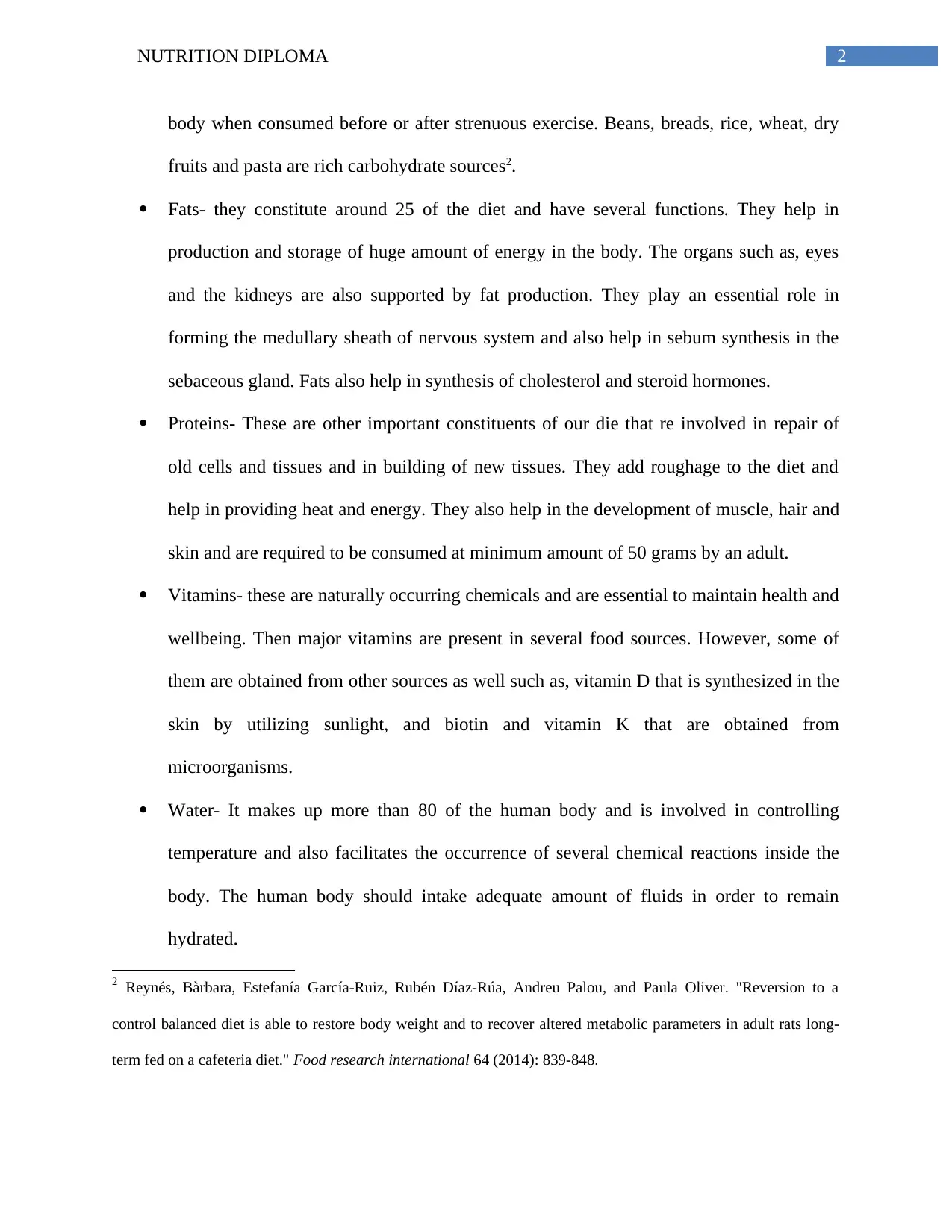
2NUTRITION DIPLOMA
body when consumed before or after strenuous exercise. Beans, breads, rice, wheat, dry
fruits and pasta are rich carbohydrate sources2.
Fats- they constitute around 25 of the diet and have several functions. They help in
production and storage of huge amount of energy in the body. The organs such as, eyes
and the kidneys are also supported by fat production. They play an essential role in
forming the medullary sheath of nervous system and also help in sebum synthesis in the
sebaceous gland. Fats also help in synthesis of cholesterol and steroid hormones.
Proteins- These are other important constituents of our die that re involved in repair of
old cells and tissues and in building of new tissues. They add roughage to the diet and
help in providing heat and energy. They also help in the development of muscle, hair and
skin and are required to be consumed at minimum amount of 50 grams by an adult.
Vitamins- these are naturally occurring chemicals and are essential to maintain health and
wellbeing. Then major vitamins are present in several food sources. However, some of
them are obtained from other sources as well such as, vitamin D that is synthesized in the
skin by utilizing sunlight, and biotin and vitamin K that are obtained from
microorganisms.
Water- It makes up more than 80 of the human body and is involved in controlling
temperature and also facilitates the occurrence of several chemical reactions inside the
body. The human body should intake adequate amount of fluids in order to remain
hydrated.
2 Reynés, Bàrbara, Estefanía García-Ruiz, Rubén Díaz-Rúa, Andreu Palou, and Paula Oliver. "Reversion to a
control balanced diet is able to restore body weight and to recover altered metabolic parameters in adult rats long-
term fed on a cafeteria diet." Food research international 64 (2014): 839-848.
body when consumed before or after strenuous exercise. Beans, breads, rice, wheat, dry
fruits and pasta are rich carbohydrate sources2.
Fats- they constitute around 25 of the diet and have several functions. They help in
production and storage of huge amount of energy in the body. The organs such as, eyes
and the kidneys are also supported by fat production. They play an essential role in
forming the medullary sheath of nervous system and also help in sebum synthesis in the
sebaceous gland. Fats also help in synthesis of cholesterol and steroid hormones.
Proteins- These are other important constituents of our die that re involved in repair of
old cells and tissues and in building of new tissues. They add roughage to the diet and
help in providing heat and energy. They also help in the development of muscle, hair and
skin and are required to be consumed at minimum amount of 50 grams by an adult.
Vitamins- these are naturally occurring chemicals and are essential to maintain health and
wellbeing. Then major vitamins are present in several food sources. However, some of
them are obtained from other sources as well such as, vitamin D that is synthesized in the
skin by utilizing sunlight, and biotin and vitamin K that are obtained from
microorganisms.
Water- It makes up more than 80 of the human body and is involved in controlling
temperature and also facilitates the occurrence of several chemical reactions inside the
body. The human body should intake adequate amount of fluids in order to remain
hydrated.
2 Reynés, Bàrbara, Estefanía García-Ruiz, Rubén Díaz-Rúa, Andreu Palou, and Paula Oliver. "Reversion to a
control balanced diet is able to restore body weight and to recover altered metabolic parameters in adult rats long-
term fed on a cafeteria diet." Food research international 64 (2014): 839-848.
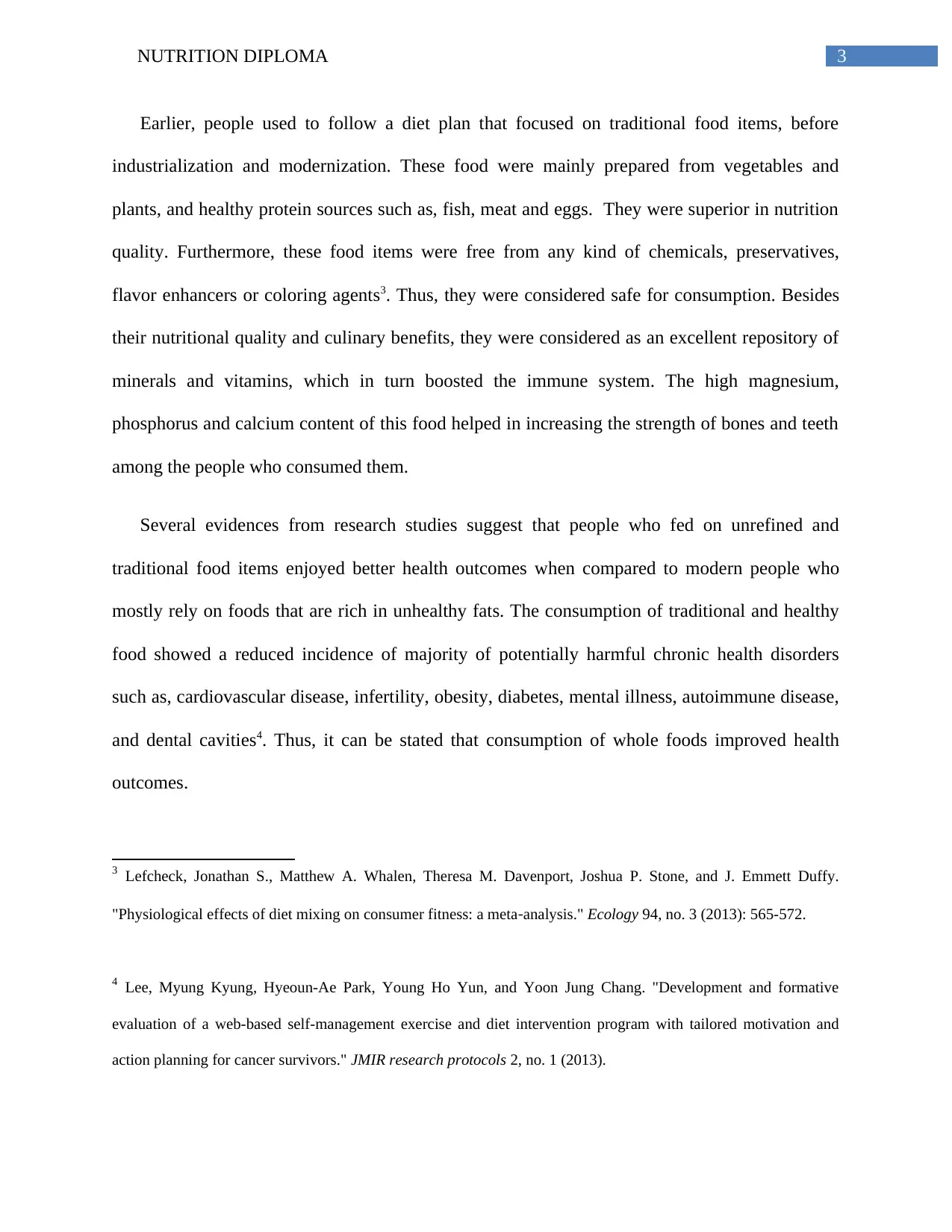
3NUTRITION DIPLOMA
Earlier, people used to follow a diet plan that focused on traditional food items, before
industrialization and modernization. These food were mainly prepared from vegetables and
plants, and healthy protein sources such as, fish, meat and eggs. They were superior in nutrition
quality. Furthermore, these food items were free from any kind of chemicals, preservatives,
flavor enhancers or coloring agents3. Thus, they were considered safe for consumption. Besides
their nutritional quality and culinary benefits, they were considered as an excellent repository of
minerals and vitamins, which in turn boosted the immune system. The high magnesium,
phosphorus and calcium content of this food helped in increasing the strength of bones and teeth
among the people who consumed them.
Several evidences from research studies suggest that people who fed on unrefined and
traditional food items enjoyed better health outcomes when compared to modern people who
mostly rely on foods that are rich in unhealthy fats. The consumption of traditional and healthy
food showed a reduced incidence of majority of potentially harmful chronic health disorders
such as, cardiovascular disease, infertility, obesity, diabetes, mental illness, autoimmune disease,
and dental cavities4. Thus, it can be stated that consumption of whole foods improved health
outcomes.
3 Lefcheck, Jonathan S., Matthew A. Whalen, Theresa M. Davenport, Joshua P. Stone, and J. Emmett Duffy.
"Physiological effects of diet mixing on consumer fitness: a meta‐analysis." Ecology 94, no. 3 (2013): 565-572.
4 Lee, Myung Kyung, Hyeoun-Ae Park, Young Ho Yun, and Yoon Jung Chang. "Development and formative
evaluation of a web-based self-management exercise and diet intervention program with tailored motivation and
action planning for cancer survivors." JMIR research protocols 2, no. 1 (2013).
Earlier, people used to follow a diet plan that focused on traditional food items, before
industrialization and modernization. These food were mainly prepared from vegetables and
plants, and healthy protein sources such as, fish, meat and eggs. They were superior in nutrition
quality. Furthermore, these food items were free from any kind of chemicals, preservatives,
flavor enhancers or coloring agents3. Thus, they were considered safe for consumption. Besides
their nutritional quality and culinary benefits, they were considered as an excellent repository of
minerals and vitamins, which in turn boosted the immune system. The high magnesium,
phosphorus and calcium content of this food helped in increasing the strength of bones and teeth
among the people who consumed them.
Several evidences from research studies suggest that people who fed on unrefined and
traditional food items enjoyed better health outcomes when compared to modern people who
mostly rely on foods that are rich in unhealthy fats. The consumption of traditional and healthy
food showed a reduced incidence of majority of potentially harmful chronic health disorders
such as, cardiovascular disease, infertility, obesity, diabetes, mental illness, autoimmune disease,
and dental cavities4. Thus, it can be stated that consumption of whole foods improved health
outcomes.
3 Lefcheck, Jonathan S., Matthew A. Whalen, Theresa M. Davenport, Joshua P. Stone, and J. Emmett Duffy.
"Physiological effects of diet mixing on consumer fitness: a meta‐analysis." Ecology 94, no. 3 (2013): 565-572.
4 Lee, Myung Kyung, Hyeoun-Ae Park, Young Ho Yun, and Yoon Jung Chang. "Development and formative
evaluation of a web-based self-management exercise and diet intervention program with tailored motivation and
action planning for cancer survivors." JMIR research protocols 2, no. 1 (2013).
Secure Best Marks with AI Grader
Need help grading? Try our AI Grader for instant feedback on your assignments.
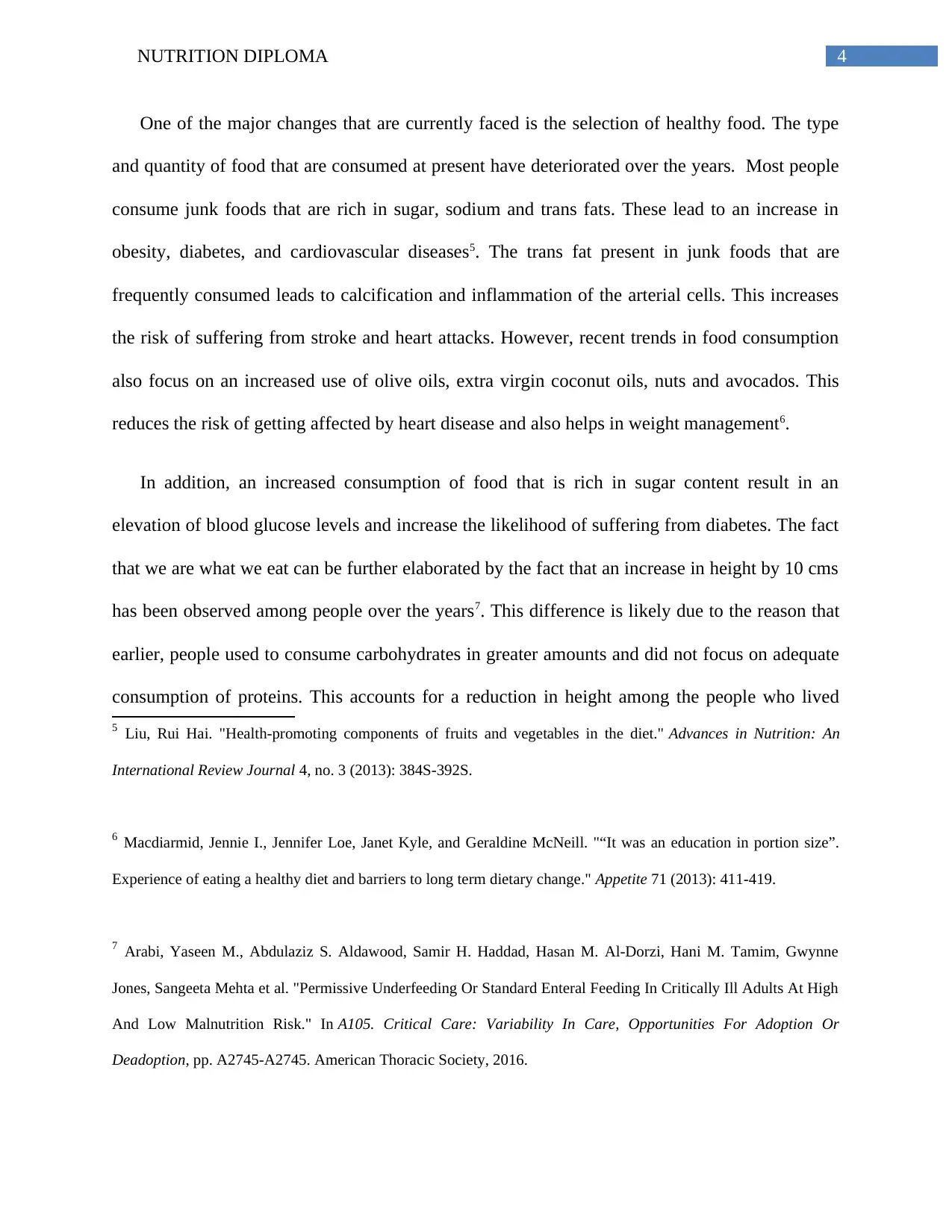
4NUTRITION DIPLOMA
One of the major changes that are currently faced is the selection of healthy food. The type
and quantity of food that are consumed at present have deteriorated over the years. Most people
consume junk foods that are rich in sugar, sodium and trans fats. These lead to an increase in
obesity, diabetes, and cardiovascular diseases5. The trans fat present in junk foods that are
frequently consumed leads to calcification and inflammation of the arterial cells. This increases
the risk of suffering from stroke and heart attacks. However, recent trends in food consumption
also focus on an increased use of olive oils, extra virgin coconut oils, nuts and avocados. This
reduces the risk of getting affected by heart disease and also helps in weight management6.
In addition, an increased consumption of food that is rich in sugar content result in an
elevation of blood glucose levels and increase the likelihood of suffering from diabetes. The fact
that we are what we eat can be further elaborated by the fact that an increase in height by 10 cms
has been observed among people over the years7. This difference is likely due to the reason that
earlier, people used to consume carbohydrates in greater amounts and did not focus on adequate
consumption of proteins. This accounts for a reduction in height among the people who lived
5 Liu, Rui Hai. "Health-promoting components of fruits and vegetables in the diet." Advances in Nutrition: An
International Review Journal 4, no. 3 (2013): 384S-392S.
6 Macdiarmid, Jennie I., Jennifer Loe, Janet Kyle, and Geraldine McNeill. "“It was an education in portion size”.
Experience of eating a healthy diet and barriers to long term dietary change." Appetite 71 (2013): 411-419.
7 Arabi, Yaseen M., Abdulaziz S. Aldawood, Samir H. Haddad, Hasan M. Al-Dorzi, Hani M. Tamim, Gwynne
Jones, Sangeeta Mehta et al. "Permissive Underfeeding Or Standard Enteral Feeding In Critically Ill Adults At High
And Low Malnutrition Risk." In A105. Critical Care: Variability In Care, Opportunities For Adoption Or
Deadoption, pp. A2745-A2745. American Thoracic Society, 2016.
One of the major changes that are currently faced is the selection of healthy food. The type
and quantity of food that are consumed at present have deteriorated over the years. Most people
consume junk foods that are rich in sugar, sodium and trans fats. These lead to an increase in
obesity, diabetes, and cardiovascular diseases5. The trans fat present in junk foods that are
frequently consumed leads to calcification and inflammation of the arterial cells. This increases
the risk of suffering from stroke and heart attacks. However, recent trends in food consumption
also focus on an increased use of olive oils, extra virgin coconut oils, nuts and avocados. This
reduces the risk of getting affected by heart disease and also helps in weight management6.
In addition, an increased consumption of food that is rich in sugar content result in an
elevation of blood glucose levels and increase the likelihood of suffering from diabetes. The fact
that we are what we eat can be further elaborated by the fact that an increase in height by 10 cms
has been observed among people over the years7. This difference is likely due to the reason that
earlier, people used to consume carbohydrates in greater amounts and did not focus on adequate
consumption of proteins. This accounts for a reduction in height among the people who lived
5 Liu, Rui Hai. "Health-promoting components of fruits and vegetables in the diet." Advances in Nutrition: An
International Review Journal 4, no. 3 (2013): 384S-392S.
6 Macdiarmid, Jennie I., Jennifer Loe, Janet Kyle, and Geraldine McNeill. "“It was an education in portion size”.
Experience of eating a healthy diet and barriers to long term dietary change." Appetite 71 (2013): 411-419.
7 Arabi, Yaseen M., Abdulaziz S. Aldawood, Samir H. Haddad, Hasan M. Al-Dorzi, Hani M. Tamim, Gwynne
Jones, Sangeeta Mehta et al. "Permissive Underfeeding Or Standard Enteral Feeding In Critically Ill Adults At High
And Low Malnutrition Risk." In A105. Critical Care: Variability In Care, Opportunities For Adoption Or
Deadoption, pp. A2745-A2745. American Thoracic Society, 2016.
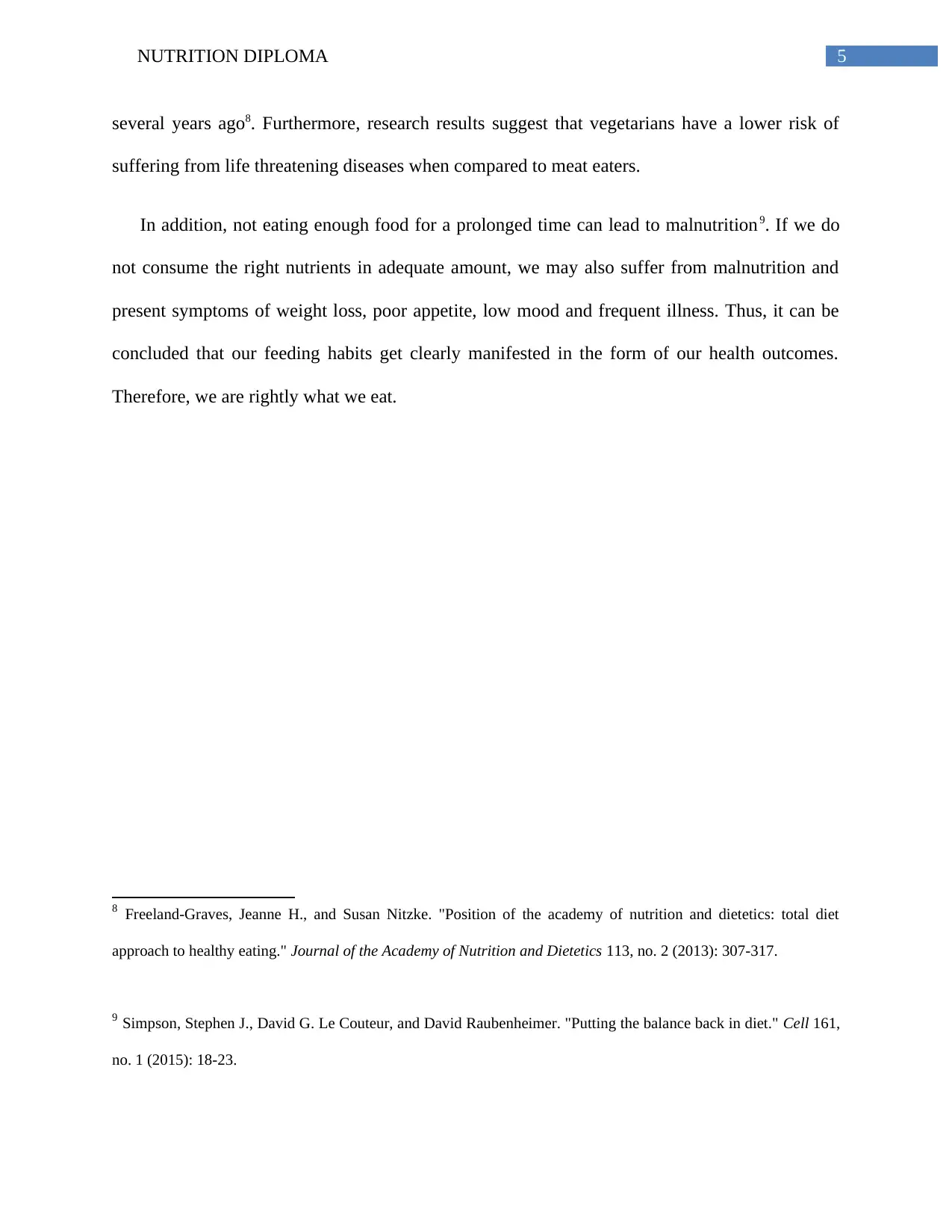
5NUTRITION DIPLOMA
several years ago8. Furthermore, research results suggest that vegetarians have a lower risk of
suffering from life threatening diseases when compared to meat eaters.
In addition, not eating enough food for a prolonged time can lead to malnutrition9. If we do
not consume the right nutrients in adequate amount, we may also suffer from malnutrition and
present symptoms of weight loss, poor appetite, low mood and frequent illness. Thus, it can be
concluded that our feeding habits get clearly manifested in the form of our health outcomes.
Therefore, we are rightly what we eat.
8 Freeland-Graves, Jeanne H., and Susan Nitzke. "Position of the academy of nutrition and dietetics: total diet
approach to healthy eating." Journal of the Academy of Nutrition and Dietetics 113, no. 2 (2013): 307-317.
9 Simpson, Stephen J., David G. Le Couteur, and David Raubenheimer. "Putting the balance back in diet." Cell 161,
no. 1 (2015): 18-23.
several years ago8. Furthermore, research results suggest that vegetarians have a lower risk of
suffering from life threatening diseases when compared to meat eaters.
In addition, not eating enough food for a prolonged time can lead to malnutrition9. If we do
not consume the right nutrients in adequate amount, we may also suffer from malnutrition and
present symptoms of weight loss, poor appetite, low mood and frequent illness. Thus, it can be
concluded that our feeding habits get clearly manifested in the form of our health outcomes.
Therefore, we are rightly what we eat.
8 Freeland-Graves, Jeanne H., and Susan Nitzke. "Position of the academy of nutrition and dietetics: total diet
approach to healthy eating." Journal of the Academy of Nutrition and Dietetics 113, no. 2 (2013): 307-317.
9 Simpson, Stephen J., David G. Le Couteur, and David Raubenheimer. "Putting the balance back in diet." Cell 161,
no. 1 (2015): 18-23.
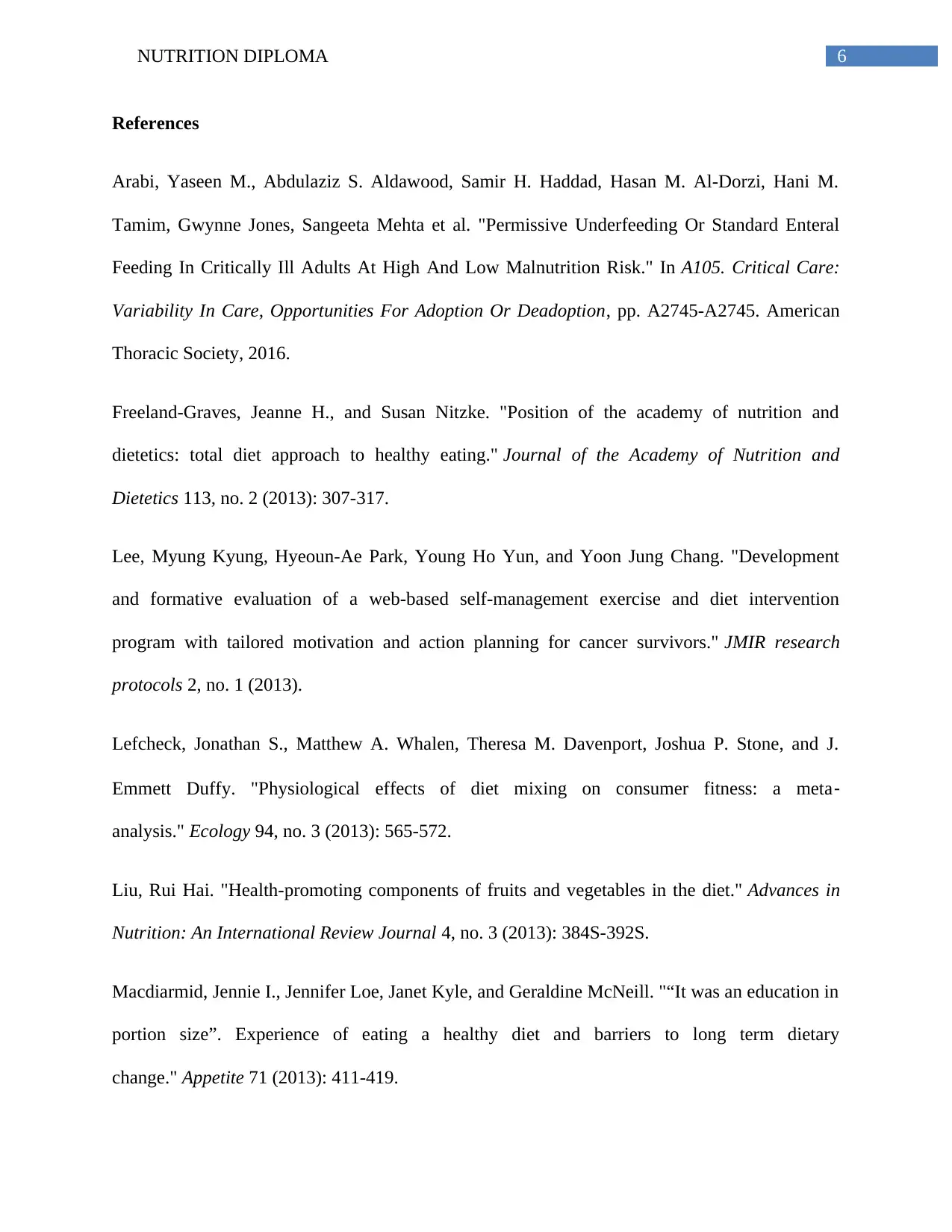
6NUTRITION DIPLOMA
References
Arabi, Yaseen M., Abdulaziz S. Aldawood, Samir H. Haddad, Hasan M. Al-Dorzi, Hani M.
Tamim, Gwynne Jones, Sangeeta Mehta et al. "Permissive Underfeeding Or Standard Enteral
Feeding In Critically Ill Adults At High And Low Malnutrition Risk." In A105. Critical Care:
Variability In Care, Opportunities For Adoption Or Deadoption, pp. A2745-A2745. American
Thoracic Society, 2016.
Freeland-Graves, Jeanne H., and Susan Nitzke. "Position of the academy of nutrition and
dietetics: total diet approach to healthy eating." Journal of the Academy of Nutrition and
Dietetics 113, no. 2 (2013): 307-317.
Lee, Myung Kyung, Hyeoun-Ae Park, Young Ho Yun, and Yoon Jung Chang. "Development
and formative evaluation of a web-based self-management exercise and diet intervention
program with tailored motivation and action planning for cancer survivors." JMIR research
protocols 2, no. 1 (2013).
Lefcheck, Jonathan S., Matthew A. Whalen, Theresa M. Davenport, Joshua P. Stone, and J.
Emmett Duffy. "Physiological effects of diet mixing on consumer fitness: a meta‐
analysis." Ecology 94, no. 3 (2013): 565-572.
Liu, Rui Hai. "Health-promoting components of fruits and vegetables in the diet." Advances in
Nutrition: An International Review Journal 4, no. 3 (2013): 384S-392S.
Macdiarmid, Jennie I., Jennifer Loe, Janet Kyle, and Geraldine McNeill. "“It was an education in
portion size”. Experience of eating a healthy diet and barriers to long term dietary
change." Appetite 71 (2013): 411-419.
References
Arabi, Yaseen M., Abdulaziz S. Aldawood, Samir H. Haddad, Hasan M. Al-Dorzi, Hani M.
Tamim, Gwynne Jones, Sangeeta Mehta et al. "Permissive Underfeeding Or Standard Enteral
Feeding In Critically Ill Adults At High And Low Malnutrition Risk." In A105. Critical Care:
Variability In Care, Opportunities For Adoption Or Deadoption, pp. A2745-A2745. American
Thoracic Society, 2016.
Freeland-Graves, Jeanne H., and Susan Nitzke. "Position of the academy of nutrition and
dietetics: total diet approach to healthy eating." Journal of the Academy of Nutrition and
Dietetics 113, no. 2 (2013): 307-317.
Lee, Myung Kyung, Hyeoun-Ae Park, Young Ho Yun, and Yoon Jung Chang. "Development
and formative evaluation of a web-based self-management exercise and diet intervention
program with tailored motivation and action planning for cancer survivors." JMIR research
protocols 2, no. 1 (2013).
Lefcheck, Jonathan S., Matthew A. Whalen, Theresa M. Davenport, Joshua P. Stone, and J.
Emmett Duffy. "Physiological effects of diet mixing on consumer fitness: a meta‐
analysis." Ecology 94, no. 3 (2013): 565-572.
Liu, Rui Hai. "Health-promoting components of fruits and vegetables in the diet." Advances in
Nutrition: An International Review Journal 4, no. 3 (2013): 384S-392S.
Macdiarmid, Jennie I., Jennifer Loe, Janet Kyle, and Geraldine McNeill. "“It was an education in
portion size”. Experience of eating a healthy diet and barriers to long term dietary
change." Appetite 71 (2013): 411-419.
Paraphrase This Document
Need a fresh take? Get an instant paraphrase of this document with our AI Paraphraser
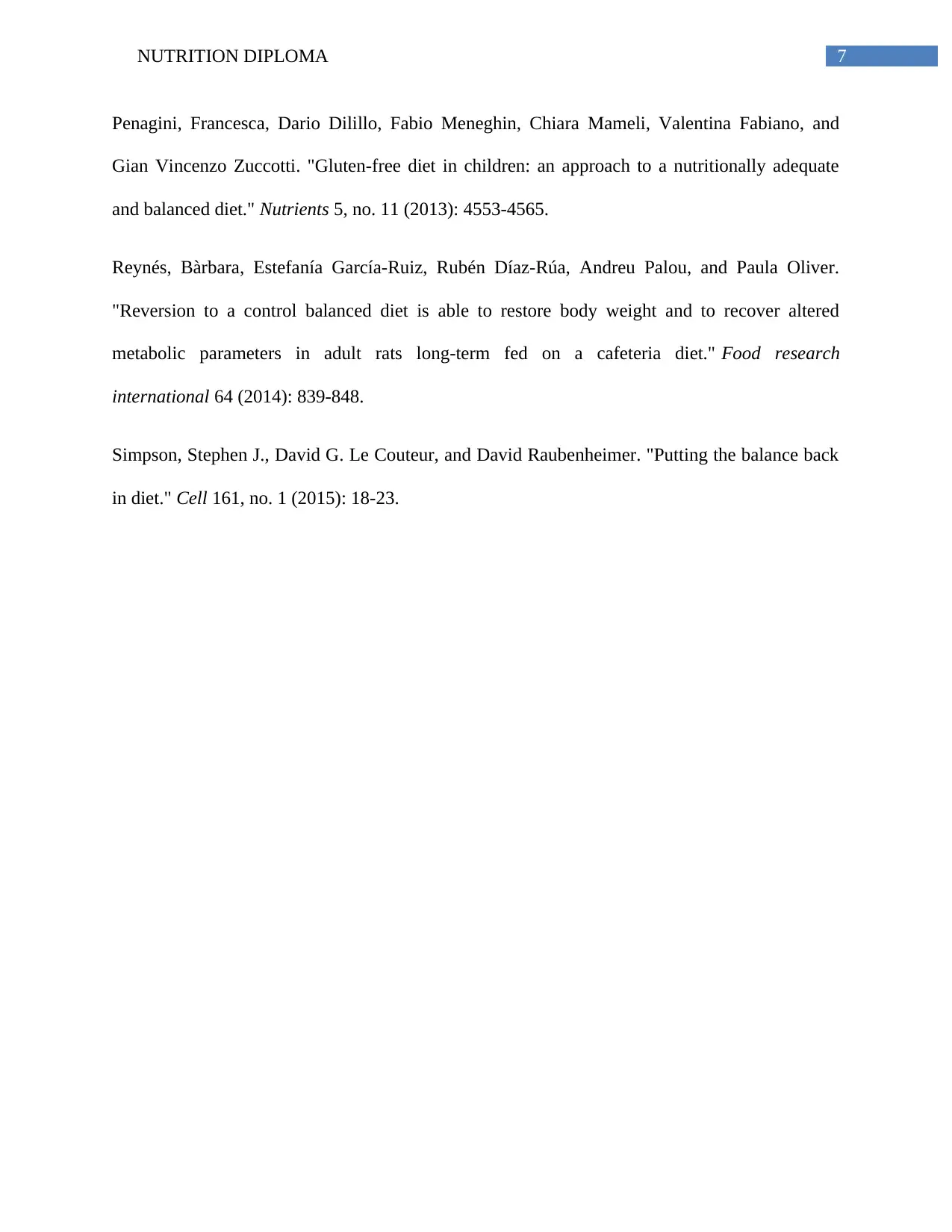
7NUTRITION DIPLOMA
Penagini, Francesca, Dario Dilillo, Fabio Meneghin, Chiara Mameli, Valentina Fabiano, and
Gian Vincenzo Zuccotti. "Gluten-free diet in children: an approach to a nutritionally adequate
and balanced diet." Nutrients 5, no. 11 (2013): 4553-4565.
Reynés, Bàrbara, Estefanía García-Ruiz, Rubén Díaz-Rúa, Andreu Palou, and Paula Oliver.
"Reversion to a control balanced diet is able to restore body weight and to recover altered
metabolic parameters in adult rats long-term fed on a cafeteria diet." Food research
international 64 (2014): 839-848.
Simpson, Stephen J., David G. Le Couteur, and David Raubenheimer. "Putting the balance back
in diet." Cell 161, no. 1 (2015): 18-23.
Penagini, Francesca, Dario Dilillo, Fabio Meneghin, Chiara Mameli, Valentina Fabiano, and
Gian Vincenzo Zuccotti. "Gluten-free diet in children: an approach to a nutritionally adequate
and balanced diet." Nutrients 5, no. 11 (2013): 4553-4565.
Reynés, Bàrbara, Estefanía García-Ruiz, Rubén Díaz-Rúa, Andreu Palou, and Paula Oliver.
"Reversion to a control balanced diet is able to restore body weight and to recover altered
metabolic parameters in adult rats long-term fed on a cafeteria diet." Food research
international 64 (2014): 839-848.
Simpson, Stephen J., David G. Le Couteur, and David Raubenheimer. "Putting the balance back
in diet." Cell 161, no. 1 (2015): 18-23.
1 out of 8
Related Documents
Your All-in-One AI-Powered Toolkit for Academic Success.
+13062052269
info@desklib.com
Available 24*7 on WhatsApp / Email
![[object Object]](/_next/static/media/star-bottom.7253800d.svg)
Unlock your academic potential
© 2024 | Zucol Services PVT LTD | All rights reserved.





